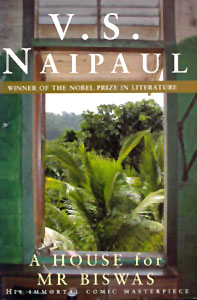 The saga of a common life, the story of daily life of Mohun Biswas, the protagonist is nicely illustrated in "A house for Mr. Biswas". The title echoes the storyline quite eloquently.
The saga of a common life, the story of daily life of Mohun Biswas, the protagonist is nicely illustrated in "A house for Mr. Biswas". The title echoes the storyline quite eloquently.
Sir Vidiadhar Surajprasad Naipaul popularly known as V. S. Naipaul was born on 17th august 1932. He is considered as the leading novelist of the English-speaking Caribbean, winner of the Nobel Prize in literature in 2001. Naipaul`s writings dealt with the cultural confusion of the Third World and the problem of an outsider, a feature of his own experience as an Indian in the West Indies, a West Indian in England, and a nomadic intellectual in a postcolonial world as well. He was a literate person. Born in a small town in Trinidad into a family of Indian Brahmin origin he was very sharp from his childhood only. His father, Seepersad Naipaul, was a correspondent for the Trinidad Guardian. He also published short stories. When Naipaul was six years only the family moved to Port of Spain. Seepersad Naipaul died of a heart attack in 1953. But this happened before success came to his son. He had encouraged Naipaul in his writing aspirations, telling him in a letter: "Don`t be scared of being an artist. D. H. Lawrence was an artist through and through; and, for the time being at any rate, you should think as Lawrence. Remember what he used to say, `Art for my sake.`" At the age of 18 he had written his first novel that was rejected by the publisher.
Synopsis:
`A House for Mr. Biswas` by V. S. Naipaul is one of the handfuls of true classics written at the backdrop of the Second World War. This is also the greatest novel ever written by someone who lived and grew up in the Third World. It is a story told with great compassion and humor of Mohun Biswas, a man who is protagonist here. The novel chronicles Mr. Biswas`s sad but chased struggle to attain a level of dignity among people sunk in stupidity and a mania for status. This book reflects Naipaul`s especially pessimistic non-ideological conservatism. He sees all too clearly how the problems of the Third World are a product of certain type of congenital dysfunction. This is the tragedy of the novel. The people he describes are victims of their own states of mind. Any attempt to liberate them would surely fail, because sicknesses cannot be cured from the soul. Biswas realizes he can do nothing about his in-laws. They are hopeless cases. When they move to a country state, instead of harvesting the many orange trees on the property, they begin chopping them down so they can pick the oranges that much easier. By this time, Biswas is too much of a fatalist even to be angry with this any more.
This book by V. S. Naipaul is an acclaimed novel by the author, which is published by the Vintage.
In this story the noble laureate V. S. Naipaul illustrates the extraordinary account of an ordinary man and his struggle to provide for his family. The story depicts the pain and sorrow of one`s life in an interesting way. This novel has the impression of an epic, as it is a huge creation of Naipaul.













